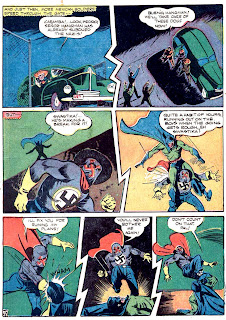The Hangman (Bob Dickering) had an interesting gimmick. When he cornered the guy he was after the shadow of the gallows fell on the felon's face. I wondered how he did that...then I watched one of those “reality” shows where we’re not supposed to think about a platoon of cameramen, lighting techs, sound guys, etc., following these “real” people around in their “real” daily endeavors. Maybe Hangman had a lighting guy who stood over his shoulder, and when the time was right would hold up a tiny gallows in front of a powerful light. Okay...so it’s a comic book and they don't have cameramen. I just needed to get that out, because Hangman's gimmick always bugged me, and if they explained it in any of the Hangman stories I've missed it (or forgotten).
This story, which comes from Pep Comics #34 (1942) is a good example of the series. Bob Fujitani, working in his early style with overtones of Will Eisner’s influence, drew some very dynamic and dramatic pages. There's even a scene of a guy getting shot through the head, which wasn't exactly typical of these stories, but gory stuff did happen. M.L.J. Magazines, Inc., publishers, was into the action, violence and horror that appalled parents and grownups across America. They also sold to servicemen who were more likely to handle this sort of thing, but it was the kids everybody worried about. After a time the line began concentrating on their teenage comics and out of bloody M.L.J. cleancut Archie Comics was born. Well, cleancut compared to this episode of Hangman. I remember some sexy stuff going on in Archie, but no one got a bullet through the brain.
I'm including a page on editor Harry Shorten. Shorten did comics, paperback book publishing, a comic strip (“There Oughta Be A Law” with Al Fagaly) and then comics again in the sixties with T.H.U.N.D.E.R. Agents. All of that was ahead of Shorten when this biography was written, but you can see from it that Shorten took to the industry early on.

























{ 0 nhận xét... read them below or add one }
Đăng nhận xét